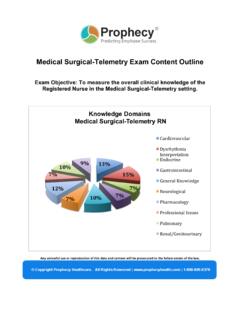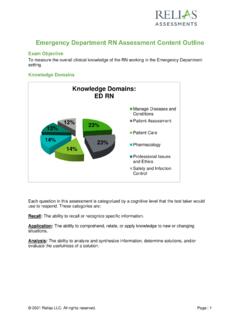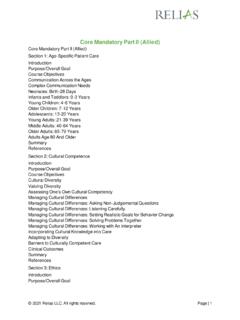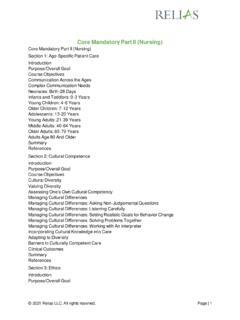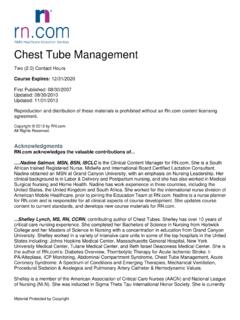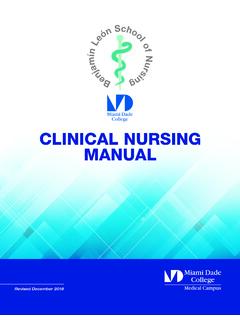Transcription of LPN Long-term Care Exam Content Outline
1 Any unlawful use or reproduction of this data and Content will be prosecuted to the fullest extent of the law. LPN Long-term Care Exam Content Outline Exam Objective: To measure the overall clinical knowledge of the Licensed Practical Nurse in the Long-term Care setting. 22%15%12%22%11%8%11%Knowledge Domains:LPN LTCC linical PracticeGeneral KnowledgeInfection ControlPharmacologyProfessional/Ethical IssuesPsychosocial & CommunicationResident Safety Any unlawful use or reproduction of this data and Content will be prosecuted to the fullest extent of the law. Each question in this assessment is categorized by a cognitive level that the test taker would use to respond.
2 These categories are: Recall: The ability to recall or recognize specific information. Application: The ability to comprehend, relate, or apply knowledge to new or changing situations. Analysis: The ability to analyze and synthesize information, determine solutions, and/or evaluate the usefulness of a solution. I. Clinical Practice A. Knowledge of common interventions associated with residents experiencing acute chest pain. B. Knowledge of anatomy, physiology, and signs and symptoms (acute and chronic) of congestive heart failure. C. Knowledge of pharmacologic and dietary factors that contribute to CHF exacerbation. D. Knowledge of dietary restrictions such as clear liquid diet post diagnostic procedure(s).
3 E. Knowledge of pathophysiology of common cardiac disease processes, including discharge teaching, such as CHF, CAD, MI etc. F. Knowledge of common cardiac emergency protocols and when to initiate treatment for emergency situations. G. Knowledge of initial treatment protocols for acute myocardial infarction (MI). H. Knowledge of tracheal suctioning, including proper technique, timing, maintaining sterility, etc. II. General Knowledge A. Knowledge of pathophysiology, observation findings, and treatment protocols for common disease processes, including but not limited to: 1. Diabetes/Diabetic Ketoacidosis (DKA) 2. Fluid and Electrolyte imbalance Any unlawful use or reproduction of this data and Content will be prosecuted to the fullest extent of the law.
4 3. Hypothyroidism 4. Hyperthyroidism/Graves s disease 5. Hypoglycemia 6. Hyperglycemia 7. Cushing s syndrome 8. Addison s disease 9. Hypoparathyroidism 10. Alzheimer s disease B. Knowledge of diabetic education for: 1. Insulin requirements related to secondary diseases processes 2. Early onset signs and symptoms of diabetes ( Frequent urination, increased thirst, etc.) C. Knowledge of dietary education for different disease process such as: 1. Gout 2. Renal Failure (Acute/Chronic) 3. CHF/Cardiac 4. Diabetes D. Knowledge of enteral feedings via G tube (GT), including normal findings and how to troubleshoot. E. Knowledge of abnormal/normal NG tube drainage , including amount, color, etc. F. Knowledge of pathophysiology and appropriate treatment interventions of common pulmonary conditions: 1.
5 Acute respiratory distress 2. COPD 3. Pulmonary embolism 4. Pneumothorax 5. Emphysema Any unlawful use or reproduction of this data and Content will be prosecuted to the fullest extent of the law. G. Knowledge of oxygen therapy and delivery systems, including resident and family education related to therapy. H. Knowledge of pathophysiology, observation findings, and treatment protocols for common gastrointestinal disease processes including but not limited to: 1. Pancreatitis 2. Peptic Ulcer disease 3. Gastric Ulcer I. Knowledge of normal and abnormal lab values for commonly drawn laboratory tests in the Long-term care setting. J. Knowledge of skin breakdown prevention such as: 1. Observing for skin break down on bony prominence 2.
6 Identifying signs and symptoms of a developing pressure injury III. Infection Control A. Knowledge of infection control principles: 1. Proper hand hygiene protocols 2. Personal Protective Equipment (PPE) 3. Standard precautions B. Knowledge of the different isolation precautions. 1. Airborne precautions 2. Droplet precautions 3. Contact precautions C. Knowledge of needle safety procedures. IV. Pharmacology A. Knowledge of how to perform parenteral dosage calculations and metric conversions. B. Knowledge of medication administration principles: Any unlawful use or reproduction of this data and Content will be prosecuted to the fullest extent of the law. 1. Drug classifications and indications 2. Resident education 3.
7 Dietary considerations/contraindications 4. Signs/symptoms of toxicity 5. Baseline vital signs 6. Subcutaneous injection sites C. Knowledge of tapering medications to minimize side effects. D. Knowledge of medication contraindications based on resident status. E. Knowledge of anticoagulant antidote medication administration. F. Knowledge of narcotic reversal agent medication administration. G. Knowledge of how to monitor for adverse side effects. H. Knowledge of medication contraindications related to known drug allergies. I. Knowledge of holding certain medications related to dialysis schedule and imaging procedures that requires contrast dye. J. Knowledge of common cardiac medications used in the Long-term care setting, including: 1.
8 Appropriate knowledge of cardiac medication parameters ( Blood pressure and heart rate) 2. Indications for use of common cardiac medications ( Lisinopril, Metoprolol, Digoxin, etc.) 3. Side effects of commonly prescribed cardiac medications K. Knowledge of contraindications for anticoagulant medication therapy L. Knowledge of vaccine contraindications ( Influenza vaccine). M. Knowledge of IM medication administration using the Z-track method. N. Knowledge of medical abbreviations commonly used in the Long-term care setting ( OS, OU, OD, PRN, etc.) Any unlawful use or reproduction of this data and Content will be prosecuted to the fullest extent of the law. V. Professional/Ethical Issues A. Knowledge of principles and protocols for advance healthcare directives.
9 B. Knowledge of principles of resident privacy and HIPAA guidelines. C. Knowledge of prioritizing resident rounds after shift report. D. Knowledge of principles for obtaining informed consent. E. Knowledge of various religious beliefs and practices as it relates to the healthcare setting. VI. Psychosocial and Communication A. Knowledge of therapeutic communication techniques for residents with suicidal ideation and psychological conditions. B. Knowledge of common nursing interventions that accompany suicidal precautions. C. Knowledge of principles regarding cultural diversity and protocols for communicating with non-English speaking residents. D. Knowledge of effective communication for residents with disability ( hearing loss).
10 VII. Resident Safety A. Knowledge of care for residents in restraints. B. Knowledge of various resident precautions for safety such as: 1. Aspiration precautions 2. Bleeding precautions 3. Seizure precautions 4. High-fall risk C. Knowledge of non-ambulatory resident transfer from bed to chair or vice versa. D. Knowledge of using different equipment to prevent resident falls such as: 1. Bed alarms Any unlawful use or reproduction of this data and Content will be prosecuted to the fullest extent of the law. 2. Mechanical lift 3. Walker 4. Wheelchair
